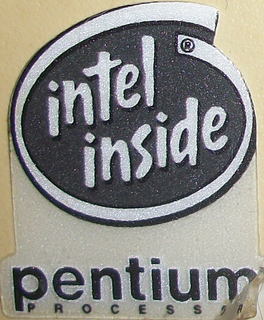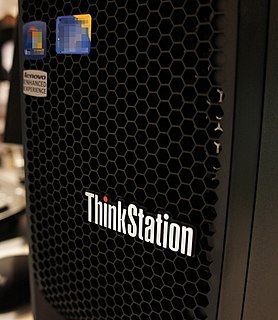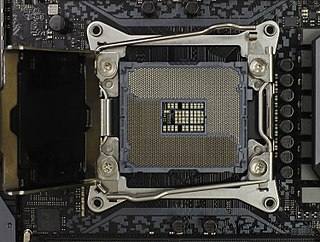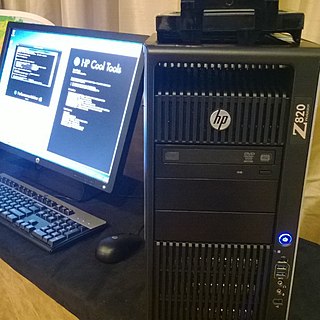Xeon W is a brand of x86 processors designed, manufactured, and marketed by Intel, targeted at the workstation market. The brand has been used for processors under several architectures:

Xeon is a brand of x86 microprocessors designed, manufactured, and marketed by Intel, targeted at the non-consumer workstation, server, and embedded system markets. It was introduced in June 1998. Xeon processors are based on the same architecture as regular desktop-grade CPUs, but have advanced features such as support for ECC memory, higher core counts, more PCI Express lanes, support for larger amounts of RAM, larger cache memory and extra provision for enterprise-grade reliability, availability and serviceability (RAS) features responsible for handling hardware exceptions through the Machine Check Architecture. They are often capable of safely continuing execution where a normal processor cannot due to these extra RAS features, depending on the type and severity of the machine-check exception (MCE). Some also support multi-socket systems with two, four, or eight sockets through use of the Quick Path Interconnect (QPI) bus.
Slot 2 refers to the physical and electrical specification for the 330-lead Single Edge Contact Cartridge used by some of Intel's Pentium II Xeon and certain models of the Pentium III Xeon.
The Intel Core microarchitecture is a multi-core processor microarchitecture unveiled by Intel in Q1 2006. It is based on the Yonah processor design and can be considered an iteration of the P6 microarchitecture introduced in 1995 with Pentium Pro. High power consumption and heat intensity, the resulting inability to effectively increase clock rate, and other shortcomings such as an inefficient pipeline were the primary reasons why Intel abandoned the NetBurst microarchitecture and switched to a different architectural design, delivering high efficiency through a small pipeline rather than high clock rates. The Core microarchitecture initially did not reach the clock rates of the NetBurst microarchitecture, even after moving to 45 nm lithography. However after many generations of successor microarchitectures which used Core as their basis, Intel managed to eventually surpass the clock rates of Netburst with the Devil's Canyon microarchitecture reaching a base frequency of 4 GHz and a maximum tested frequency of 4.4 GHz using 22 nm lithography.
As of 2020, the x86 architecture is used in most high end compute-intensive computers, including cloud computing, servers, workstations, and many less powerful computers, including personal computer desktops and laptops. The ARM architecture is used in most other product categories, especially high-volume battery powered mobile devices such as smartphones and tablet computers.

Intel Core 2 is the processor family encompassing a range of Intel's consumer 64-bit x86-64 single-, dual-, and quad-core microprocessors based on the Core microarchitecture. The single- and dual-core models are single-die, whereas the quad-core models comprise two dies, each containing two cores, packaged in a multi-chip module. The Core 2 range was the last flagship range of Intel desktop processors to use a front-side bus.

Pentium is a brand used for a series of x86 architecture-compatible microprocessors produced by Intel. The original Pentium was released in 1993. After that, the Pentium II and Pentium III were released.

The Platform Controller Hub (PCH) is a family of Intel's single-chip chipsets, first introduced in 2009. It is the successor to the Intel Hub Architecture, which used two chips - a northbridge and southbridge instead, and first appeared in the Intel 5 Series.

Intel Core are streamlined midrange consumer, workstation and enthusiast computers central processing units (CPU) marketed by Intel Corporation. These processors displaced the existing mid- to high-end Pentium processors at the time of their introduction, moving the Pentium to the entry level. Identical or more capable versions of Core processors are also sold as Xeon processors for the server and workstation markets.

Skylake is the codename used by Intel for a processor microarchitecture that was launched in August 2015 succeeding the Broadwell microarchitecture. Skylake is a microarchitecture redesign using the same 14 nm manufacturing process technology as its predecessor, serving as a tock in Intel's tick–tock manufacturing and design model. According to Intel, the redesign brings greater CPU and GPU performance and reduced power consumption. Skylake CPUs share their microarchitecture with Kaby Lake, Coffee Lake, Cannon Lake, Whiskey Lake, and Comet Lake CPUs.

Xeon Phi is a series of x86 manycore processors designed and made by Intel. It is intended for use in supercomputers, servers, and high-end workstations. Its architecture allows use of standard programming languages and application programming interfaces (APIs) such as OpenMP.

The ThinkStation products from Lenovo are professional workstations designed for high-end computing. In 2008, Lenovo expanded the focus of its "THINK" brand to include workstations, with the ThinkStation S10 being the first model released. In 2014, Lenovo introduced the P Series workstations.
Intel Sandy Bridge-based Xeon microprocessors are microprocessors based on the Intel's 32 nm Sandy Bridge architecture for servers, workstations, and high-end desktops. It succeeds the six-core Gulftown/Westmere-EP processor which used the older LGA 1366 package, and uses LGA 2011, LGA 1356 and LGA 1155 socket depending on the package.
The Xeon D is a brand of x86 system on a chip designed, manufactured, and marketed by Intel, targeted at the microserver market. It was announced in 2014, with the first products released in 2015. Related to the Xeon brand of workstation and server processors are based on the same architecture as server-grade CPUs, with support for ECC memory, higher core counts, support for larger amounts of RAM, larger cache memory. Unique to the Xeon D line, emphasis was also made on low power consumption, and integrated hardware blocks such as a network interface controllers, a PCI express root complex, and USB and SATA controllers.
Ice Lake is Intel's codename for the 10th generation Intel Core mobile and 3rd generation Xeon Scalable server processors based on the new Sunny Cove microarchitecture. Ice Lake represents an Architecture step in Intel's Process-Architecture-Optimization model. Produced on the second generation of Intel's 10 nm process, 10 nm+, Ice Lake is Intel's second microarchitecture to be manufactured on the 10 nm process, following the limited launch of Cannon Lake in 2018. However, Intel altered their naming scheme in 2020 for the 10 nm process. In this new naming scheme, Ice Lake's manufacturing process is called simply 10 nm, without any appended pluses.

LGA 2066, also called Socket R4, is a CPU socket by Intel that debuted with Skylake-X and Kaby Lake-X processors in June 2017. It replaces Intel's LGA 2011-3 (R3) in the performance, high-end desktop and Workstation platforms, while LGA 3647 replaces LGA 2011-3 (R3) in the server platforms based on Skylake-SP.
Cascade Lake is an Intel codename for a 14 nanometer server, workstation and enthusiast processor microarchitecture, launched in April 2019. In Intel's Process-Architecture-Optimization model, Cascade Lake is an optimization of Skylake. Intel states that this will be their first microarchitecture to support 3D XPoint-based memory modules. It also features Deep Learning Boost instructions and mitigations for Meltdown and Spectre. Intel officially launched new Xeon Scalable SKUs on February 24, 2020.

The ThinkPad P series line of laptops is produced by Lenovo and was introduced by the company as a successor to the previous ThinkPad W series. With 15.6" and 17.3" screens, the ThinkPad P series saw the reintroduction of physically large laptops into the ThinkPad line. Marketed largely as portable workstations, many P series laptops can be configured with high-end quad-core, hexa-core or octo-core Intel processors as well as ECC memory and a discrete Nvidia Quadro GPU. The P series offers ISV certifications from software vendors such as Adobe and Autodesk for various CAD software. The P52 and P72 models are the last current Lenovo laptops with a dedicated magnesium structural frame.
Intel Xe, earlier known unofficially as Gen12, is a GPU architecture developed by Intel.

HP Z is a series of professional workstation computers developed by HP. The first-generation desktop products were announced in March 2009, replacing HP's xw-series workstations. The product line expanded to mobile with the announcement of Z Book in September 2013, replacing HP's EliteBook W-series mobile workstations. The Z workstations mainly compete against Dell Precision workstations, Lenovo's ThinkStation or ThinkPad P-series workstations, as well as the Apple Mac Pro and MacBook Pro.